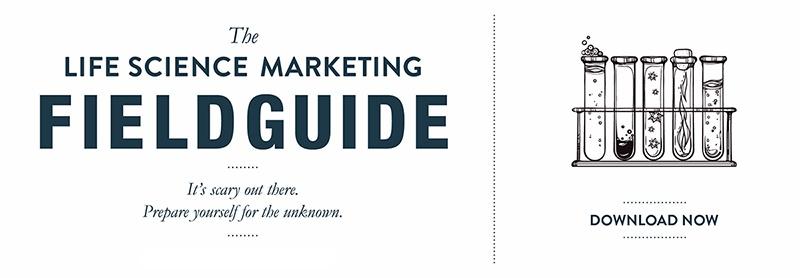We recently created The Life Science Marketing Field Guide here at CG Life, because – let’s face it – your job as a marketer in the life sciences isn’t getting any easier. The days of a fixed annual budget, a simple marketing mix (that probably relied heavily on print media), and well-defined, concrete objectives, are gone. We live in an era of chaos and uncertainty as business and reimbursement models change overnight and audiences are elusive, fragmented and highly skeptical. Today, your job requires nimble marketing programs that can thrust and parry with the marketplace. As a marketer, you have to:
- keep tabs on a wide array of marketing tools and technologies
- understand the psychology of a diverse audience base
- track competitors (real and imagined)
- and somehow still deliver (on brand on budget and on time) for your sales team and C-suite.
Basically, you must be everywhere and know everything. Is this reason for you to despair? Absolutely not. While you may not be able to clone yourself to get it all done, you can follow the battle-born tips and advice in our guide. We’ve kept up with the accelerating pace of innovation – both in science and in marketing. And we help our clients through these challenges every day. Along the way, we’ve learned a thing or three about marketing.
Life Science Marketing: How We Got Here and Where We’re Going
The overall U.S. economy continued to strengthen throughout 2015 creating positive, challenging and lasting effects for the life science industry. Mid-market IPO activity (companies with market caps between $10M and $2B) decreased in 2015 versus 2014 due mainly to the fact that many public investors had rising concerns over uncertainty in the global economy, domestic politics and interest rates. Additionally, the strong economy has contributed to the availability of capital and high valuations from private financial and strategic investors. While this has put downward pressure on life science IPO activity, it has also enabled a wave of early-stage innovators in the life sciences to gain a foothold and scale commercially–particularly in the genomics and bioinformatics sectors. In 2016, life sciences companies are seeing enough long-term growth opportunity to feel cautiously optimistic about the remainder of the year and beyond. However, many life science and healthcare organizations are increasingly focused on optimizing operating performance (e.g., addressing complexity and quality in manufacturing, R&D, finance, safety and even marketing) while working within evolving regulatory and risk environments, ongoing pricing and cost pressures on medicines and devices, and the adoption of new business models enabled by scientific advances, such as the maturing of precision medicine and immune therapies. *Update Note : We are updating this in 2022 and while the COVID-19 pandemic certainly took the world on a wild ride, the life science and healthcare industry is growing at an exponential rate, establishing the argument for long-term growth in the industry. And if there was a time for life science marketing professionals to be on their game, the time is now, more than ever. Life sciences companies will need to assess the value of their initiatives from a selling perspective due to cost pressures. Importantly, amid the shift to outcomes-focused, value-based healthcare, life science companies may continue to bear the brunt of public and private payers’ efforts to control costs. Truly innovative products that address unmet needs (e.g. hepatitis C and oncology) may continue to command premium prices. An aging U.S. population and a proliferation of chronic diseases will drive continued patient demand for targeted therapies amid reform-driven drug price controls. Life sciences companies will therefore need to find a balance between innovation and efficiency. Additionally, with growing patient and payer resistance, drug and device manufacturers will find themselves increasingly having to make economic arguments in their marketing efforts to defend or gain market share.
So, What Do All of These Trends Mean For You?
The life science brands that will be successful will be those that place people at the center of their brand promise and marketing campaigns. In order to achieve this, those organizations will segment their audiences in a far more sophisticated and detailed way than ever before. These companies will gain an understanding of human needs and desired outcomes—even if they’re an enabling technology and not a therapy. If this doesn’t sound like your organization’s brand or marketing, fret not. It’s late in the game, but not too late start. And, you already have a leg up on the competition, because you can read our guide. This excerpt come straight from Chapter 1 of the Field Guide. Ready for more? Get access to the full Field Guide below. 